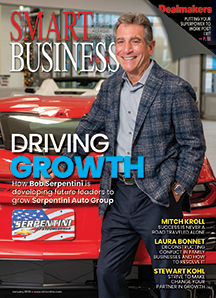Digital first
Safelite’s first transformation was easier. This time around, Feeney determined the organizational structure needed to change. He moved customer service, marketing and technology under one person. The idea was to get them to start talking to one another, but keep the departments separate.
“We believed that was the secret sauce in this whole customer-driven transformation, that the brand and the technologist would work together to redefine the needs of the customer,” he says.
Listening to its customers — including the customer effort score, which increased around 10 percentage points over the past five years — helped underscore the need to focus on digital.
Smartphones had begun to proliferate the market, so the company became solely mobile responsive. Feeney took inspiration from a Steve Jobs quote: “You’ve got to start with the customer experience and work backwards to the technology.”
After listening to customer feedback, Safelite changed its online business. Customers went from 21 clicks to get a quote to four. The company evolved from updating its website every six weeks to three or four times a month.
Feeney and his team also reorganized the technology group into an agile business model. Ideas came in and out quickly. They were tested and implemented in a series of sprints.
“With the benefit of hindsight today, I would say that that organizational decision, the design decision, was the right one for us. It allowed digital to work much faster,” he says.
The digital team within the technology group grew from five people to close to 30. Feeney says they meet with them monthly, and they want to know about more than just their results, they want to hear about their failures.
Be nimble
If you see speed as an asset, you can’t add levels of approval. This is a truth Feeney continues to reinforce.
“The more people you get involved, the more questions get asked. The more questions you get asked, then things slow down. So, we want to encourage experimentation, and with that, we want to eliminate bureaucracy, and the outcome of that is that you make a few mistakes. Some of them can be costly,” Feeney says.
For example, Safelite experimented with video advertising for about a month. It cost $1.5 million and there was no return on that investment. Feeney says the lesson learned wasn’t that it was wrong to experiment, it was the experiment’s size.
“But the biggest point for me is we complimented the team on their courage to make the decision and the speed in which they recognized that there was a mistake and brought it to us and shut it down. Nobody got in trouble for it,” he says.
Words matter, but actions matter even more when you’re trying to create culture. If your employees are questioned, they’ll hesitate next time.
“You have to allow for errors to occur. You have to have the team, the leadership understand that they’re working in a safe environment,” Feeney says.
In the same spirit, Safelite opened an innovation lab at Rev1 Venture, which houses startups.
“As we began the transformation to be a customer-driven organization in order to listen more effectively and then to create solutions for customers, you have to have a much higher curiosity factor. Some call it innovation; I prefer just to call it curiosity,” Feeney says.
Starting in 2013, the Safelite team toured innovation centers, identifying a few to study. Feeney says they learned that labs have different focuses — core business, adjacencies or transformational work — so you have to determine that upfront.
Safelite Works purposely isn’t attached to the corporate offices. Being away from processes and approvals enables the lab to operate fluidly, Feeney says.
“It allowed us to do more experimentation in a safe environment — to start to bring in startup organizations that we think can help us into an innovation lab, but kept them out of the corporate environment,” he says.

